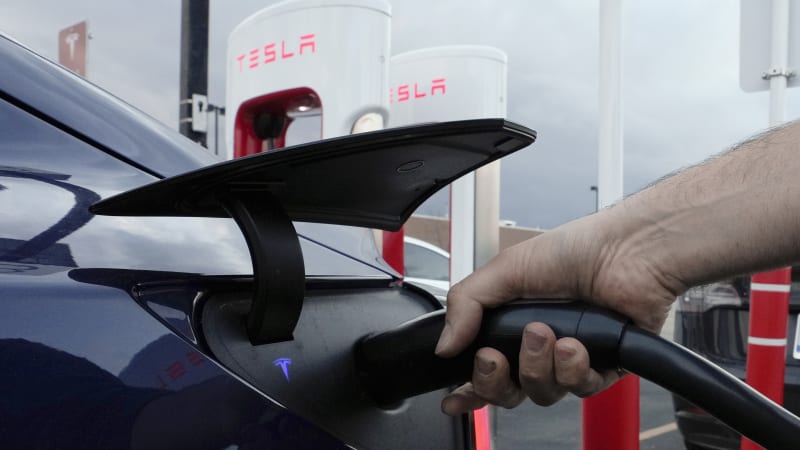Which electric cars can charge at a Tesla Supercharger?

The difference between
Tesla charging and non-Tesla charging.
Electrify America; Tesla
Tesla’s advantage has long been its charging technology and Supercharger network.
Now, more and more automakers are switching to Tesla’s charging tech.
But there are a few things non-Tesla drivers need to know about charging at a Tesla station.
A lot has hit the news cycle in recent months with regard to electric car drivers and where they can and can’t plug in. The key factor in all of that? Whether automakers switched to Tesla’s charging standard.
More car companies are shifting to Tesla’s charging tech in the hopes of boosting their customers’ confidence in going electric.
Here’s what it boils down to:
If you currently drive a Tesla, you can keep charging at Tesla charging locations, which use the company’s North American Charging Standard (NACS), which has long served it well. The chargers are thinner, more lightweight and easier to wrangle than other brands.
If you currently drive a non-Tesla EV, you have to charge at a non-Tesla charging station like that of Electrify America or EVgo — which use the Combined Charging System (CCS) — unless you stumble upon a Tesla charger already equipped with the Magic Dock adapter. For years, CCS tech dominated EVs from everyone but Tesla.
Starting next year, if you drive a non-Tesla EV (from the automakers that have announced they’ll make the switch), you’ll be able to charge at all Supercharger locations with an adapter. And by 2025, EVs from some automakers won’t even need an adaptor.
Here’s how to charge up, depending on which EV you have:
Ford
Ford was the earliest traditional automaker to team up with Tesla for its charging tech.
Current Ford EV owners — those driving a Ford electric vehicle already fitted with a CCS port — will be able to use a Tesla-developed adapter to access Tesla Superchargers starting in the spring. That means that, if you own a Mustang Mach-E or Ford F-150 Lightning, you will need the adapter in order to use a Tesla station come 2024.
But Ford will equip its future EVs with the NACS port starting in 2025 — eliminating the need for any adapter. Owners of new Ford EVs will be able to pull into a Supercharger station and juice up, no problem.
General Motors
GM will also allow its EV drivers to plug into Tesla stations.
Much like Ford, GM EV drivers can start to use the Tesla charging network even before the automaker equips its cars with NACS.
Starting next year, whether you’re driving a GMC Hummer, Cadillac Lyriq, or other GM electric car, you can use a Tesla charger, so long as you have an adapter.
GM will build its EVs with the NACS port starting in 2025. From that point on, GM EV drivers won’t need an adapter to charge at a Tesla location.
Volvo
The Volvo EX90.
Volvo
Current drivers of Volvo EVs can start to use an adapter to use Tesla chargers sometime mid-next year.
Those who buy an electric Volvo starting in 2025 can expect the cars will be made with the NACS port from then onward.
Polestar

The 2025 Polestar 4.
Polestar
The same rules apply for owners of Polestar EVs.
You can start using the chargers in 2024 with an adapter, and expect the full experience a year later with a model year 2025 Polestar.
Mercedes-Benz

The Mercedes-Benz EQS SUV.
Mercedes-Benz
The German automaker just announced it will adopt Tesla’s NACS.
Mercedes-Benz EV drivers will have access to the Tesla network via an adapter beginning next year.
Mercedes will implement the NACS port into its vehicles built starting in 2025.
Some automakers have not yet announced that they will make their EVs compatible with Tesla chargers. For example, Lucid is not planning on making the switch right away.

The
Lucid Air Grand Touring Performance.
Tim Levin/Insider
Lucid CEO Peter Rawlinson recently said he’s not yet convinced about the industry-wide switch to the Tesla NACS tech, but it’s likely the startup will eventually follow suit. That means Lucid drivers have to charge at a location where CCS is readily available.
Stellantis
The Jeep-maker told Reuters in a recent statement it would evaluate a potential switch to NACS.
Hyundai

The 2023 Hyundai Ioniq 5.
Hyundai
Hyundai said it is also considering it.
It gets tricky when you look at other charging stations

Electrify America.
Electrify America
Currently, non-Tesla EV drivers can plug in at an Electrify America or EVgo charger given both the vehicles and the stations are equipped to handle CCS-enabled charging.
Several charging companies are now planning to convert their equipment to NACS. (You can keep an eye on which companies that is with this helpful tracker from consultancy EVAdoption.)
That means that for drivers of non-Tesla EVs, built with the NACS port in the future (for many of them, starting in 2025), these non-Tesla stations will also be able to accommodate them.
There’s a lot to keep track of in the world of EV charging. But given how important charging is to an EV owner’s experience, the space is bound to get more exciting in the coming years.
Are you a non-Tesla EV owner? Are you planning to use the adapter to be able to charge at Tesla stations starting next year? Do you wish you waited to buy your EV until after it was built with the NACS port? Do you have a tip or opinion to share? Contact this reporter at astjohn@insider.com.


